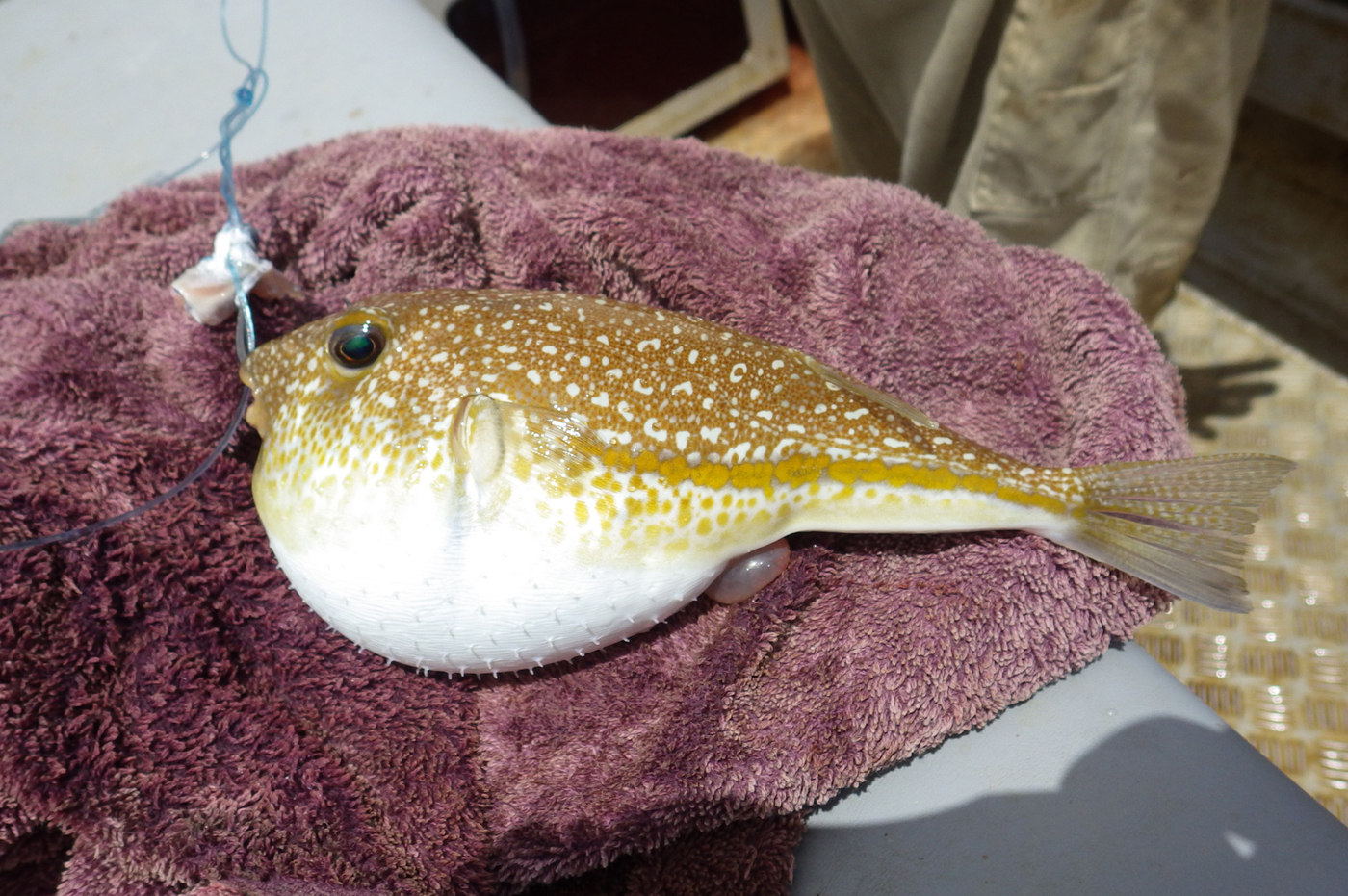Highfin Toadfish, Torquigener altipinnis (Ogilby 1891)

A Highfin Toadfish, Torquigener altipinnis, from Norfolk Island in the Tasman Sea, February 2017. Source: mscott / iNaturalist.org. License: CC By Attribution-NonCommercial
Summary:
A pale brownish, greyish or dark brown puffer covered in small spines, with distinct round to sickle-shaped whitish spots interspersed with many smaller, pale flecks, and a series of pale blotches along the side. The holotype was described as having a bright yellow lower half, underside of the body and fins.
Cite this page as:
Bray, D.J. 2021, Torquigener altipinnis in Fishes of Australia, accessed 30 Jun 2025, https://fishesofaustralia.net.au/Home/species/880
Highfin Toadfish, Torquigener altipinnis (Ogilby 1891)
More Info
|
Distribution |
North of Townsville, Queensland, to Nadgee, New South Wales; also Lord Howe Island and Norfolk Island in the Tasman Sea. Elsewhere the species occurs in New Zealand (Kermadec Islands). Inhabits inshore and offshore sandy areas. |
|
Features |
Dorsal fin 8-10; Anal fin 7-8; Pectoral fin 15-18; Caudal fin 11; Vertebrae 7-9 + 11-12. Body elongate, rounded dorsally, flattened ventrally, tapering to a narrow caudal peduncle; head length 2.6-3.2 in SL. Mouth small, terminal, width 3.1-5.0 in HL; lips thin, with numerous short papillae; chin prominent; nasal organ a short, erect papilla, set in a low depression well forward of eye. Eye moderate, slightly elongate and dorsally adnate, upper border interrupts dorsal profile, lower border well above level of corner of mouth. dorsal spines only moderately dense; a few spines project posteriorly from prebranchial margin, which lacks fleshy papillae; dorsal surface with distinct, pale to milk-white spots, which are rounded or sometimes sickle-shaped, and interspersed with many smaller, pale flecks; frontals at posterior of prefrontals just wider than mid-dorsal surface of ethmoid. Pectoral fin short, dorsally elongate, rounded, first ray very short, top of fin base well below lower margin of eye; dorsal and anal fins elongate, pointed; caudal fin truncate. |
|
Colour |
Upper surface of the head yellowish-brown, the lips and sides of the head much darker; the back and upper half of the sides grey, ornamented with numerous milk-white spots, a few of which have a dark centre; lower half of sides, entire undersurface, and fins bright yellow (Ogilby 1891). Freshly-preserved material is characterized by a linear series of interconnecting, sometimes pale, centred blotches on the side of the body. |
|
Similar Species |
The similar Torquigener hicksi differs in part from T. altipinnis in having the top of the pectoral fin base much higher in relation to the lower margin of the eye. Additionally, the interorbital space in T. hicksi is much broader than that of T. altipinnis. |
|
Etymology |
The specific name altipinnis is form the Latin alti (= elongate) and pinnis (= fin), in reference to high, falcate dorsal and anal fins. |
|
Species Citation |
Tetrodon altipinnis Ogilby 1891, Records of the Australian Museum 1(6): 110. Type locality: Lord Howe Island. |
|
Author |
Bray, D.J. 2021 |
|
Resources |
Highfin Toadfish, Torquigener altipinnis (Ogilby 1891)
References
Allen, G.R., Hoese, D.F., Paxton, J.R., Randall, J.E., Russell, B.C., Starck, W.A., Talbot, F.H. & Whitley, G.P. 1976. Annotated checklist of the fishes of Lord Howe Island. Records of the Australian Museum 30(15): 365-454 figs 1-2
Francis, M. 1993. Checklist of the coastal fishes of Lord Howe, Norfolk, and Kermadec Islands, southwest Pacific Ocean. Pacific Science 47(2): 136-170 figs 1-2
Francis, M.P. 2019. Checklist of the coastal fishes of Lord Howe, Norfolk and Kermadec Islands, southwest Pacific Ocean. figshare. Collection. https://doi.org/10.6084/m9.figshare.c.4428305.v2
Hardy, G.S. 1983. Revision of Australian species of Torquigener Whitley (Tetraodontiformes: Tetraodontidae), and two new generic names for Australian puffer fishes. Journal of the Royal Society of New Zealand 13(1/2): 1-48 https://doi.org/10.1080/03036758.1983.10415335Open access
Johnson, J.W. 2010. Fishes of the Moreton Bay Marine Park and adjacent continental shelf waters, Queensland, Australia. pp. 299-353 in Davie, P.J.F. & Phillips, J.A. Proceedings of the Thirteenth International Marine Biological Workshop, The Marine Fauna and Flora of Moreton Bay. Memoirs of the Queensland Museum 54(3)
Matsuura, K. 2001. Ostraciidae, Aracanidae, Triodontidae, Tetraodontidae. pp. 3948-3957 in Carpenter, K.E. & Niem, T.H. (eds). The Living Marine Resources of the Western Central Pacific. FAO Species Identification Guide for Fisheries Purposes. Rome : FAO Vol. 6 pp. 3381-4218.
Matsuura, K. 2015. Taxonomy and systematics of tetraodontiform fishes: a review focusing primarily on progress in the period from 1980 to 2014. Ichthyological Research 62: 72–113. https://doi.org/10.1007/s10228-014-0444-5
Ogilby, J.D. 1891. Description of a new fish from Lord Howe Island. Records of the Australian Museum 1(6): 110 https://doi.org/10.3853/j.0067-1975.1.1891.1241
Paulin, C., Stewart, A., Roberts, C. & McMillan, P. 1989. New Zealand fish: a complete guide. National Museum of New Zealand Miscellaneous Series 19: 1-279
Shao, K., Liu, M., Jing, L., Hardy, G., Leis, J.L. & Matsuura, K. 2014. Torquigener altipinnis. The IUCN Red List of Threatened Species 2014: e.T193704A2263174. https://dx.doi.org/10.2305/IUCN.UK.2014-3.RLTS.T193704A2263174.en. Downloaded on 22 February 2021.
Stewart, A.L. & Roberts, C.D. 2015. 248 Family Tetraodontidae. pp. 1730-1740 in Roberts, C.D., Stewart, A.L. & Struthers, C.D. (eds). The Fishes of New Zealand. Wellington : Te Papa Press Vol. 4 pp. 1153-1748.
Waite, E.R. 1904. Catalogue of the fishes of Lord Howe Island. Records of the Australian Museum 5(3): 187–230 (as Spheroides altipinnis)
Whitley, G.P. 1968. Some fishes from New South Wales. Proceedings of the Royal Zoological Society of New South Wales 1966–67: 32-40 3 figs 2 pls (as Gastrophysus perlevis)






